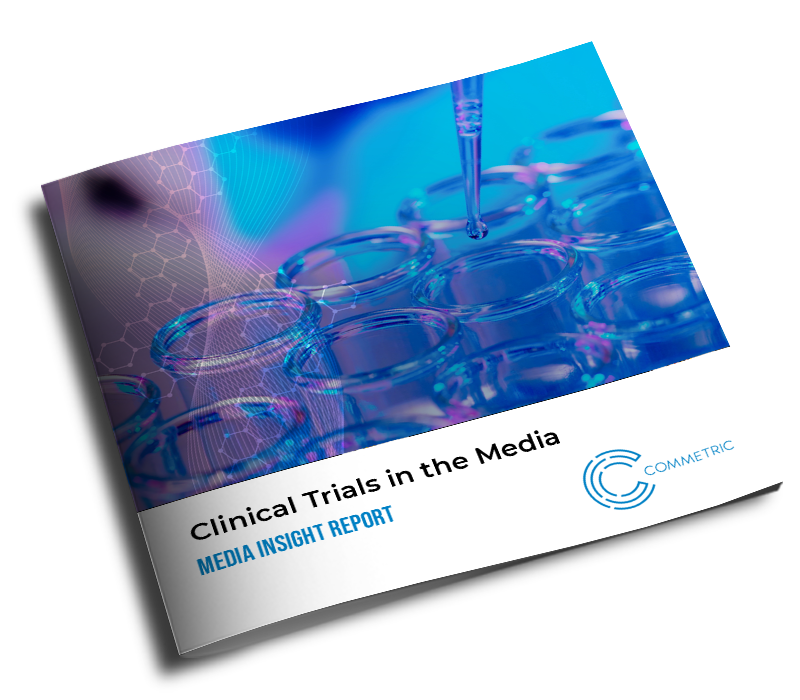Download Commetric’s comprehensive media analytics report on clinical trial communications.
Communicating clinical trial results is one of the biggest challenges for PR and comms pros in pharma. Distilling scientific data into comprehensible messages that resonate with diverse audiences, from patients to physicians to investors, requires a meticulous approach.
Media analytics offers some obvious advantages, such as pinpointing relevant journalists, monitoring the coverage and assessing media sentiment. But beyond these immediate benefits, advanced media analytics, particularly when melding AI with expert human analysis, can help you to:
1. Own the debate around your specific therapeutic area
Turning clinical data into news is not easy. You can start by utilising thematic and message analysis to see how the media perceives your specific therapeutic area and how your message could stand out.
Let’s take as an example oncology – the therapeutic area which emerged as the most prominent in terms of media traction, as we found analysing 826 English-language articles published since the start of the year.
Oncology consistently garners heightened media attention because of its constant influx of newsworthy progress. With advancements such as using AI in cancer diagnosis, or genomic medicine providing insights into the genetic basis of cancers, the oncology narrative is rapidly evolving. By aligning their communications with these prevalent narratives, pharma players can more effectively capture media attention and subsequently, inform and influence the larger public discourse surrounding oncology.
Moreover, PR and comms pros should analyse how spokespeople frame clinical trial results to discern how and why their statements resonate with the media. The most influential spokespeople in our sample – Susan Galbraith, executive vice president of oncology R&D at AstraZeneca, and Hesham Abdullah, GSK’s senior vice president and global head of oncology development – underscore the importance of strategic framing.
By juxtaposing AstraZeneca‘s new lung cancer treatment against the existing standard, Susan Galbraith placed emphasis on progress and change, enticing the audience with the allure of a potential game-changer. Similarly, Abdullah’s narrative accentuated the transformational capability of GSK’s endometrial cancer treatment, emphasising its ability to address unmet needs. Both approaches were crafted to draw media interest by projecting the respective drugs as revolutionary, tapping into the media’s propensity for narratives that showcase innovation.
2. Conduct competitive analysis when challenging established therapies
Diving deep into competitive media analysis not only aids in strategic positioning, but also furnishes a competitive edge when articulating clinical trial outcomes for treatments that challenge already established ones.
In our sample, Novo Nordisk and Eli Lilly emerged as the most influential organisations due to a spirited debate around weight loss solutions – recent trial outcomes proposed that Eli Lilly’s Mounjaro might surpass Novo Nordisk’s Ozempic in terms of weight loss efficacy.
Intensifying the competition, Pfizer‘s drug danuglipron also showcased weight loss outcomes paralleling those of Ozempic in a mid-stage study.
Understanding such shifts and nuances in the media conversation allows PR pros to craft more effective strategies. For instance, knowing how Mounjaro’s trial results were framed, Eli Lilly‘s communications team can emphasise the unique benefits of their product, such as its dual hormone-mimicking capability, while also addressing potential concerns like side effects. Conversely, Novo Nordisk might focus on the established track record of Ozempic and Wegovy and on other aspects such as ease of use or cost. Pfizer, on the other hand, can leverage the promising mid-stage data of danuglipron to position itself as a formidable competitor, while also highlighting its endeavours into oral therapies like lotiglipron.
3. Identify potential reputational pitfalls
Clinical trials inherently grapple with risk and sometimes even contentious subject matters that can evoke powerful emotions and controversies. Granular insights from media analytics can help anticipate potential issues, enabling a proactive approach—referred to as “issues management.”
Our analysis found that the most recent concern when it comes to clinical trial outcomes is diversity.
Many journalists pointed out that the inclusion of diverse populations in clinical trials has plummeted to its lowest level in a decade, despite recent efforts by industry players, including the FDA and Big Pharma.
The media’s amplified focus on diversity and inclusion metrics in clinical trials implies that any major clinical trial announcements lacking representation can swiftly escalate into a PR crisis. This heightened scrutiny underscores the urgency for pharmaceutical companies to proactively address and communicate about these metrics, lest they face significant backlash and potential reputational damage.
Several pharmaceutical giants have started taking proactive measures and earned positive media attention in the process. Eli Lilly, for example, has repurposed its mobile lab units, initially developed during the Covid pandemic, to aid recruitment in underserved communities. Pfizer, meanwhile, is harnessing the power of social media to target a broader range of participants. Sanofi entered a five-year deal with research platform Thread as part of its efforts to integrate more technology and increase diversity in its clinical trials. Furthermore, Novartis is leading a commendable effort with its Beacon of Hope initiative, focusing on enhancing clinical trial inclusion and addressing health disparities.
Download Commetric’s media analytics report for more insights into the clinical trial coverage of 250 pharmaceutical and biotechnology companies

